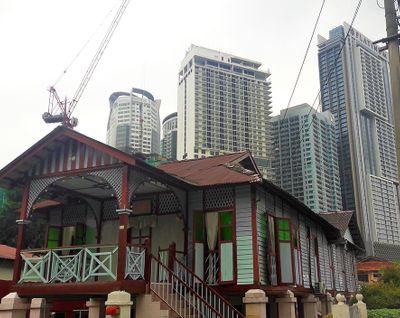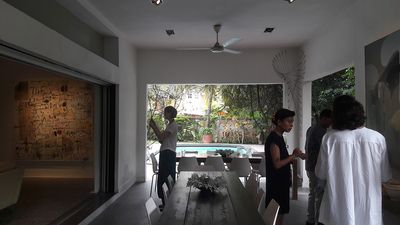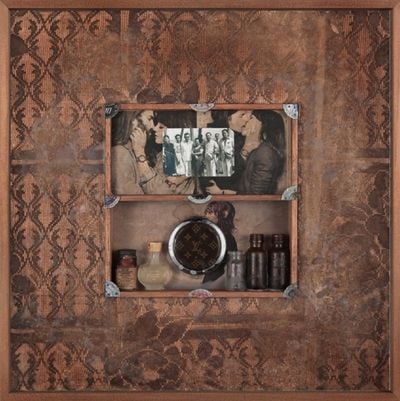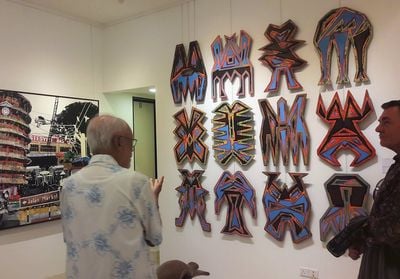Binding an artscape: Gallery Weekend Kuala Lumpur

Traditional house in Kampung Baru, Kuala Lumpur. Photo: Tessa Moldan.
The success of any city-wide art event lies in its ability to bring a location's artistic fabric to the fore. Such is the ambition of Shalini Ganendra, founder and director of Shalini Ganendra Fine Art and initiator of the annual Gallery Weekend Kuala Lumpur (GWKL), whose second edition occurred between 8 and 10 December 2017. Titled Mapping the Multi-discipline, this exceptional effort brought together 23 galleries, art spaces and institutions as a means of showcasing not only Kuala Lumpur's cultural landscape but also artistic production from elsewhere in the region.
Kuala Lumpur's relatively small population of just under 2 million (neighbouring Singapore has a population of over 5 million and Jakarta, just under 10 million) is dispersed in a manner that seems to defy any sense of urban cohesion. Underpasses and overpasses slice through the city, sectioning skyscrapers and precarious enclaves that face the threat of erasure to make way for development. Exemplary of this is the Malay quarter of Kampung Baru, a hamlet in central Kuala Lumpur defined by traditional wooden houses, whose land value has been estimated at around USD1.4 billion. The artistic infrastructure of the city is similarly disjointed. Many of Kuala Lumpur's strongest private galleries and art spaces are located in quiet residential areas or on the city's outskirts, beyond walking distance or public transport routes; an immediate limitation to those who might want to fit the whole of GWKL's programme into the weekend.
Tucked away in the green of tropical plants, 26-year-old gallery TAKSU houses a tight-knit stable of artists from the region. Complete with swimming pool, mango and rambutan trees, the gallery's residential address plays richly to the imagination of both devoted and potential collectors. Presented especially in conjunction with GWKL, TAKSU's end-of-year exhibition Reflections (8–30 December 2017) was a group exhibition—impeccably curated by gallery managers Syukur Ali and Rini Hashim—that focused on painting.
On the gallery's top floor, works by international artists including Sara Zaher, Yayo Pena Diaz and Veronica Green were on view, while across the bright, airy ground floor, varied pieces by established and emerging local and Southeast Asian artists—including Sand T Kalloch and Fendy Zakri—were presented. These included Indonesian artist Budi Agung Kuswara's acrylic on canvas painting Buaya Sawah (2011), depicting a deep green, cartoonish crocodile whose inflated form contrasts with a background of grey, decrepit tiles: part of a series Kuswara created during his residency at the gallery during which he engaged with a collection of curious floating pool toys. To the left of Budi Agung Kuswara's work was Justice (2017), by Malaysian artist Najib Ahmad Bamadhaj: a painting that shows a mass of penguins huddled together against a judicial court in the background.
An abundance of abstract and figurative painting became a recurring theme across Kuala Lumpur during the city's gallery weekend, with the occasional interjection of sculpture and assemblage. In the case of Filipino artist Norberto Roldan's The Beginning of History and Fatal Strategies B (2011), positioned by the front door at TAKSU, two individual works are presented like curios cabinets. Each contains a wooden frame split into two levels, with small perfume bottles lined up on the bottom, and a vintage photograph of a Filipino family pasted onto another image of a Western commercial showing two couples embracing at the top—an assemblage that suggests overlapping histories and the penetration of one culture by another. (This was one of the few critically layered works spotted over the weekend—critical but decidedly less subtle was a barbed charcoal-on-canvas depiction of Aung San Syuu Kyi by Ronnie Mohammad spotted in the group exhibition Southeast Asian Icons at Nadine Fine Art, in which the leader raises a blood-stained palm on which the words 'I DON'T CARE' are scrawled.)
Approximately 20 kilometres to the west of TAKSU in the suburb of Petaling Jaya (commonly referred to by locals as 'PJ') lies an architectural beauty: Shalini Ganendra Fine Art (SGFA). SGFA is devoted to supporting both an emerging and established art scene in a gallery that advocates the notion of 'living with art'. The gallery, designed by architect Ken Yeang, assumes a residential flavour similar to TAKSU, with the leafy tangles of creepers and trees juxtaposed against concrete, modernist façades, and furniture inviting conversation and contemplation dotted throughout each space. (SGFA has taken its environmentalist design a step further, however, with features that include a wind catcher, bioswales and turf ramps.)
On the top floor of SGFA's sleek sanctuary, works by emerging Malaysian artists Afiq Faris, Shaq Kyok and Alena Murang provide insights into Malaysian cultural heritage through each artist's own narrative. The exhibition, aptly titled ROOTS (8 December 2017–28 February 2018), features portraits of Alena Murang's elders and family members, who belong to the Kelabit ethnic group in Borneo. These mixed media on paper and canvas works in tones of black, white and sepia act as nostalgic conduits for Murang's personal anecdotes—in Pu' Ayam (2014), a rooster is portrayed beneath the profile of an elder who Murang told us gave her the affectionate name 'ayam', or 'chicken', as a child. In the case of Afiq Faris, the artist incorporates traditional Batik printing methods into his inkjet prints on jute that depict domestic surroundings that come together as playful accumulations of form and colour.
A focus on places of origin was particularly felt during a visit to Publika, a gallery cluster inside a shopping centre located approximately half way between TAKSU and SGFA. Here, figurative and abstract painting reigned, and socio-political concerns remained for the most part absent—perhaps a reflection of the market and the primary interests of the 50-odd collector base situated within the country. This was particularly visible in the variety of subject matter on view in the group exhibition Bintang 5: Volume 1 at Segaris Art Center (21 November–7 January 2018), the first part of a series of exhibitions to commemorate the gallery's 50th anniversary, which includes abstract and organic forms with portraiture, landscape and surrealistic scenes as well as sculpture by graduates of differing generations from the MARA University of Technology (all works were created between 1967 and 2017). Organic forms took centre stage back at Petaling Jaya in Faizal Suhif's solo exhibition Visual Poetry at G13 Gallery (16–30 December 2017), which presented a series of over 15 large-scale printworks of structures resembling organs and plant matter in earthy tones, highlighting Suhif's deep ruminations on the relationship between man and nature.
The role of private collectors in Kuala Lumpur in fostering art in the city and beyond became apparent as encounters with a number of figures took place throughout the weekend. Upon our visit to Publika, Interpr8 gallery's founder N. Parameswaran gave a passionate chronicle of his acquisitions, beginning with over 1200 Vietnam War works that he accumulated during his time spent as Ambassador of Malaysia to Vietnam from 1990 to 1993. (The works are currently on a three-year loan at the National University of Singapore Museum.)
Indeed, one of the most popular events of GWKL was a tour of the Zain Azahari Collection, where 83-year-old veteran lawyer Zain Azahari introduced visitors to his incredibly diverse collection himself. The tour began with the very first works that Azahari acquired—an unassuming collection of early abstract watercolour and oil on canvas paintings from the 1960s by one of the first modernist painters in Malaysia, Latiff Mohidin. Azahari now owns over 700 modern and contemporary works by some of the region's most prominent artists—such as Bob Sick and Najib Ahmad Bamadhaj—whose works appeared in other galleries and arts spaces throughout the weekend. At one time, the collection can exhibit around 150 works in the collection's town house exhibition space (Zain Azahari resides in another town house a few doors down). Works on view during the weekend included a signature, ethereal painting in hazy swirls of fluorescent pink on black by Singaporean artist Ruben Pang (who came to hang the work himself upon its acquisition), as well as a stunning series of colourful, geometric oil and enamel on board paintings by Haffendi Anuar (Passerine, 2017), who was recently commissioned to create outdoor sculptures for Battersea Power Station in London.
Zain Azahari is devoted to fostering young artists and art appreciation in the region. During the tour, the collector explained how board members of museums are very often government figures with a lack of understanding as to how art should be presented to the public. This results in a stagnation of overall artistic understanding or appreciation, which makes the efforts of private individuals such as Zain Azahari and Shalini Ganendra in a developing an art scene in Malaysia all the more important.
Thoughts on collecting, exhibiting works and art practice were shared in the two talks held over 8 and 9 December at the National Visual Arts Gallery and Islamic Arts Museum, entitled 'Curating Conversations' and 'Collecting & Creating'. At the National Visual Arts Gallery, Artist Herwig Kempinger discussed his experience as the President of the Association of Visual Artists Vienna Secession, the world's oldest independent exhibition institution specifically dedicated to contemporary art founded in 1897 by Gustav Klimt and other artists dissatisfied with the state of the arts in Austria at the time. What followed was a talk by Christine Boehler, lecturer and programme coordinator at Cross-Disciplinary Strategies department of the University of Applied Arts Vienna, who reinforced the importance of collecting art as an inextinguishable and therefore conscientious form of consumption. The two speakers then came together with moderator Sharmin Paramaswaran—a Kuala Lumpur-based curator and daughter of N. Paramaswaran, owner of Interpr8—to draw parallels between the arts infrastructure in Austria versus Malaysia with a particular emphasis on arts funding. Kempinger stated that around 30 percent of the budget of Austria's Ministry for Education, the Arts and Culture goes to arts institutions, a figure he expressed as low to the dismay of one audience member who pointed out the almost non-existent funding available in Malaysia.
On the following day at the Islamic Arts Museum, Hugo Weihe, former International Director of Asian Art at Christie's, discussed the practice of collecting art and the importance of art institutions to house these collections and bring interest to a city, making reference to the infamous Louvre Abu Dhabi and the Fondation Louis Vuitton in Paris. His presentation was then followed by a discussion with urbanist Sarah Ichioka, who drew out further points on Weihe's talk, such as the role of institutions in the digital age. Both days offered interesting reflections on Kuala Lumpur and the road ahead from a top down perspective, providing an ideological blueprint of the potential artistic infrastructure of the city.
With the next Gallery Weekend running from 30 November to 2 December 2018, it will be interesting to see how Kuala Lumpur's artistic infrastructure will progress in a year's time. By unfurling its artistic fabric, GWKL pushes the city to collaborate in unprecedented ways, generating self-awareness amongst various galleries, centres, institutions and arts professionals. Importantly, this provides a starting point from which to discuss how the city's identity could be mapped in the future, its influence within Asia yet to be defined.—[O]















































































































































































